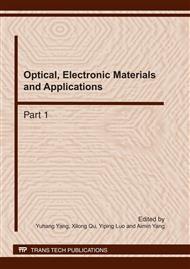p.70
p.75
p.81
p.86
p.91
p.96
p.101
p.106
p.111
Attached FBG Strain Sensor Based on Thermal Stress Mechanism
Abstract:
Based on a novel thermal stress mechanism, a attached FBG strain sensor with temperature-compensated function was designed and manufactured. This sensor cannot only compensate temperature drift but enhance stain sensitivity. The results are as follows: this package was shown to have a near 2.0 pm/°C shift and a high strain sensitivity of 1.9pm/με in this proposed self-compensated package.
Info:
Periodical:
Pages:
91-95
Citation:
Online since:
March 2011
Authors:
Price:
Сopyright:
© 2011 Trans Tech Publications Ltd. All Rights Reserved
Share:
Citation:


